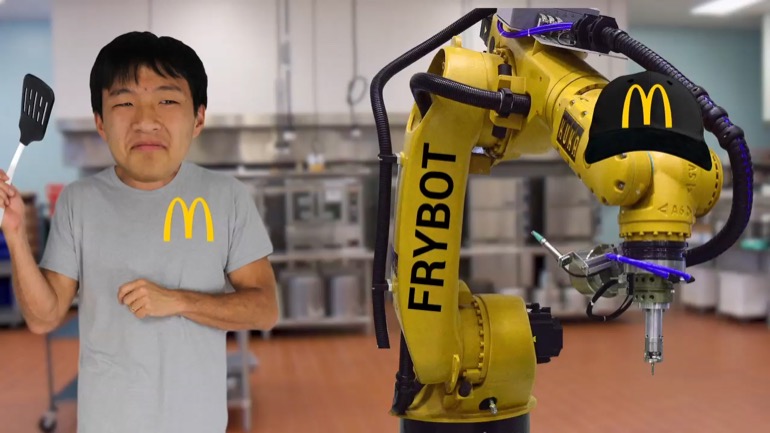ShmoopTube
Where Monty Python meets your 10th grade teacher.
Search Thousands of Shmoop Videos
Econ Videos 79 videos
What is a Production Possibilities Curve? The Production Possibilities Frontier Curve (PPF) is a statistical graphic curve that depicts the compari...
What are Income and Substitution Effects? Income effects reflects the increases or decreases in total consumption of goods and services in proporti...
How Do Companies Add Value? Companies add value by improving the client or customer experience. This can be achieved by offering better quality ser...
Econ: What are Price and Quantity Controls? 3 Views
Share It!
Transcript
- 00:00
and finance Allah shmoop what our price and quantity controls
- 00:08
All right people while the invisible hand does a lot
- 00:11
of good bringing consumer demand to producer supply at equilibrium
- 00:16
But sometimes the invisible hand can't work its magic For
- 00:19
instance in cases of monopoly on Olonga pally firms are
Full Transcript
- 00:23
incentivized to produce less quantity at higher prices you know
- 00:27
than they would if they had some competition Well in
- 00:30
cases like these the government can step in to try
- 00:33
to correct the market making it more efficient by setting
- 00:36
price and quantity controls In other cases the government may
- 00:39
set price and quantity controls in response to social issues
- 00:43
and actually creating market distortion rather than a correcting one
- 00:48
So how do price and quantity controls work If you
- 00:52
look at your typical supply and demand graph like this
- 00:54
take a look at the axes on the X axis
- 00:56
We've got quantity on the Y axis We've got price
- 00:59
Since the X axis and a Y axis are price
- 01:01
and quantity on the graph well those are the two
- 01:04
things the government has to play with to affect the
- 01:06
markets No excess demand or supply means we're at equilibrium
- 01:11
where supply and demand cross like right there This means
- 01:13
the supply a good or service is sold at matches
- 01:17
the same supply demand it all for an agreed upon
- 01:20
price by buyers and sellers What market inefficiencies produce what's
- 01:24
called a dead weight loss which we can see on
- 01:27
the graph right there representing the cost of inefficiency When
- 01:31
there's either excess supply or excess demand while we Khun
- 01:33
see dead weight loss the larger the deadweight loss triangle
- 01:37
on the graph while the farther away from equilibrium The
- 01:40
market is when there's excess demand That means there's a
- 01:43
shortage of supply when lots of people want a limited
- 01:46
quantity of stuff while prices skyrocket On the flip side
- 01:50
when there's excess supply demand shrinks When there's an abundance
- 01:53
of something compared to you know how much of it
- 01:56
people want Well prices fall sometimes Government price in quantity
- 02:00
controls are designed to reduce deadweight loss and other times
- 02:02
these controls create deadweight loss First up price controls A
- 02:07
government can set a price control basically setting price limitations
- 02:12
on firms in a certain market Well there's two main
- 02:15
types of price controls Price ceilings and price floors Well
- 02:18
price ceilings mean there's an upper limit on how much
- 02:21
affirm Khun Selig odor service for For instance a government
- 02:24
might set a price ceiling on something that everyone needs
- 02:27
to keep you know affordable like food for natural monopolies
- 02:30
that affect a lot of society like utilities Internet service
- 02:34
providers and buses that buses Will governments oftentimes set a
- 02:38
price ceiling Will these air all natural monopolies since their
- 02:42
monopolies that happened spontaneously from very high fixed startup costs
- 02:46
Price ceilings on natural monopolies like these insure businesses aren't
- 02:51
taking too much advantage of their monopoly status and overcharging
- 02:55
consumers on those evil business is rent controlled areas are
- 02:58
another example of price ceilings However rent controlled areas are
- 03:02
more likely creating a dead weight loss Ten Getting rid
- 03:05
of one but artificially lowering the cost of housing that
- 03:08
creates excess demand Rent control Lower supply to since that
- 03:14
means landlords and rent controlled areas will be feeling the
- 03:17
squeeze of the price ceiling Why be a landlord in
- 03:20
an area where prices are kept artificially low Hello rent
- 03:24
control when you could be a landlord in an unregulated
- 03:27
red state area with much higher rent prices in therefore
- 03:31
profits These landlords and rent controlled areas who are making
- 03:34
less money because of government intervention are then incentivized to
- 03:37
provide housing with you know worst quality Another reason government
- 03:41
might set a price ceiling is to prevent hyper inflation
- 03:45
which history has told us happens often during war time
- 03:48
Right Well price floors are the opposite you know when
- 03:51
a government sets a lower bound on price for firms
- 03:54
While price ceilings often help consumers price floors often help
- 03:58
producers For instance governments sometimes help farmers out by setting
- 04:03
price floors on things like milk By setting the price
- 04:06
artificially high though this can create reduced a man and
- 04:10
excess supply usually does well In the case of farmers
- 04:12
governments usually set price floors along with the promise of
- 04:16
buying up any excess supply from farmers Well why does
- 04:19
the government bother helping out these farmers and keeping him
- 04:21
around Technology made farming go from meeting a ton of
- 04:25
people needing very few people for the same output of
- 04:28
food producing on mass farming equipment fancy fertilizers and pesticides
- 04:32
Ball radically transformed the farming industry Some governments have used
- 04:35
price floor simply to reduce consumer demand for a good
- 04:39
for instance making alcohol or tobacco more expensive would ideally
- 04:43
drive demand for alcohol and tobacco down well in the
- 04:46
labor market Minimum wages a price floor Here the suppliers
- 04:49
are workers not the firms Firms are demanding labor and
- 04:53
workers are supplying it to remember when the price of
- 04:56
something rises It's usually followed by a drop in demand
- 05:00
Okay so what about quantity controls Well a quantity control
- 05:04
is usually referred to as a quota and it limits
- 05:07
the quantity of a good quotas work well in cases
- 05:10
when controlling the quantity is easier or more important than
- 05:14
controlling the cost For instance a government may set a
- 05:17
quota for nuclear power plants since there's a potentially high
- 05:20
social cost If you know something went awry and the
- 05:24
international markets it's common for countries to set import quotas
- 05:28
So this quota restricts a supply of a certain good
- 05:30
from international markets so that gives the domestic country a
- 05:34
leg up against them Foreign competitors like another example of
- 05:37
quota on imported steel would mean that domestic steel firms
- 05:41
would get an advantage over imported steel while international quotas
- 05:45
benefits some domestic firms This comes at the cost of
- 05:48
everyone buying the goods meaning a steel quota in the
- 05:51
US would mean higher steel prices from domestic steel producers
- 05:54
then from cheaper foreign producers in an unregulated market A
- 05:58
limited number of hunting and fishing licenses and tags are
- 06:01
another example of quotas in order to keep hunting and
- 06:04
fishing populations you know in existence the young ones have
- 06:07
to be given time to be born grow up and
- 06:09
reproduce right Well oftentimes A combination of quotas and price
- 06:13
floors in the form of high price licenses and tags
- 06:16
are used to keep hunted and fished populations at sustainable
- 06:19
levels Setting a quota a quantity limit has similar effects
- 06:23
as a price floor Artificially restricting quantity sold means higher
- 06:26
prices and lower demand compared to free market equilibrium Well
- 06:30
if you were wondering it's not too common when a
- 06:33
capitalistic government sets a quantity minimum or floor But if
- 06:36
they did in theory it'd create a surplus of supply
- 06:38
compared to equilibrium levels and potentially would need to be
- 06:41
supported by the government like price floors on agriculture to
- 06:45
make up for the lack of demand Well for instance
- 06:47
let's say in the future the government created an enforceable
- 06:49
law on the labor market making firms hire a minimum
- 06:52
number of people in response to shrinking jobs Yes Hello
- 06:56
Robots They're coming for our jobs Firms would then be
- 06:58
forced to hire people when they wouldn't want or need
- 07:01
thio creating forced oversupply of workers on two firms Well
- 07:06
all this government regulation can breathe rebellion rebellion in the
- 07:09
form of the underground economy the market free of any
- 07:12
government regulations And yes black market milk is a thing 00:07:15.992 --> [endTime] just like black market booze Hey
Related Videos
GED Social Studies 1.1 Civics and Government
What is bankruptcy? Deadbeats who can't pay their bills declare bankruptcy. Either they borrowed too much money, or the business fell apart. They t...
What's a dividend? At will, the board of directors can pay a dividend on common stock. Usually, that payout is some percentage less than 100 of ear...
How are risk and reward related? Take more risk, expect more reward. A lottery ticket might be worth a billion dollars, but if the odds are one in...



















































































